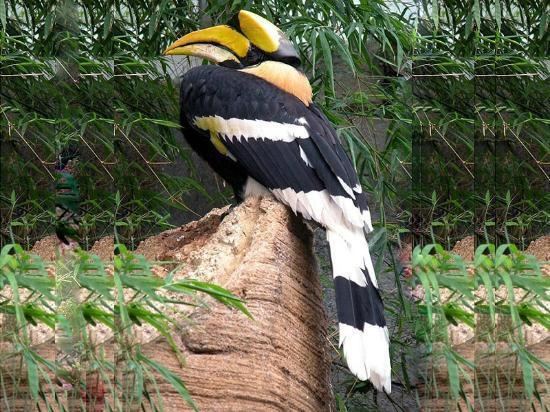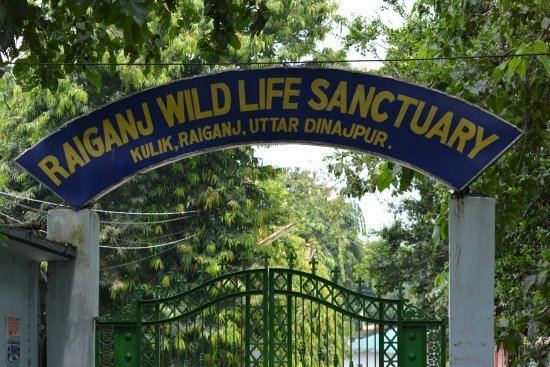Established 1985 | Area 130 ha | |
 | ||
Similar Raiganj railway station, Chintamoni Kar Bird Sanctuary, Gopegarh Eco park, Lothian Island Wildlife S, Bibhutibhushan Wildlife Sanctuary | ||
Raiganj Wildlife Sanctuary (Bengali: রায়গঞ্জ বন্যপ্রাণী অভয়ারণ্য Raegônj Bonnoprani Ôbhôearonno) (also popularly known as Kulik Bird Sanctuary) is situated near Raiganj in Uttar Dinajpur district in the Indian state of West Bengal. The bird sanctuary is home to 164 species of birds, and some 70,000 to 80,000 migratory birds visit the sanctuary every year.
Contents
- Monkey in a cage in kulik bird sanctuary in raiganj west bengal india
- Location
- Climate
- History
- Sanctuary
- Heronry
- Tourism
- References

Monkey in a cage in kulik bird sanctuary in raiganj west bengal india
Location

It is located 4 km (2.5 mi) north from the centre of Raiganj town, the district headquarters. NH 34 runs beside the sanctuary. Raiganj is 425 km (264 mi) from Kolkata and 181 km (112 mi) from Siliguri.
Climate

Temperature (degrees Celsius): summer - max. 39, min. 21; winter - max. 23, min. 6. Rainfall: 1,550 mm (July to September).
History

The development of the area began in 1970, as part of the social forestry programme of the Government of West Bengal. The department planted tree species like kadam, jarul, sisoo (Dalbergia sisoo) and eucalyptus which were classified as tropical dry deciduous forest. With the Asian openbill and other species of migratory birds flocking to the artificial forest during the hatching season, it was officially designated as the "Raiganj Wildlife Sanctuary" in the year 1985. It is popularly known as Kulik Bird Sanctuary because the river Kulik flows beside the sanctuary.
Sanctuary

It is claimed by some to be the largest bird sanctuary in Asia. However, there are other claimants to that distinction, such as Harike Pattan sanctuary, spread over 93 square miles (240 km2), in Tarn Taran district of Punjab. Bharatpur Bird Sanctuary, now known as Keoladeo National Park is considered the largest in Asia.
The area of the sanctuary is around 1.30 km2. The core area is about 0.14 km2 and the rest is buffer area. The river flows around part of the sanctuary and acts as the boundary in its eastern and southern parts. The shape of the sanctuary is that of the English alphabet "U". The sanctuary has a network of artificial canals connected with the river Kulik. During monsoon the river water enters the sanctuary, which supports a wide variety of food for the birds, particularly for the Asian openbill, whose main diet is apple snail. The sanctuary is home to 164 species of birds.
Several types of migratory birds arrive here each year from South Asian countries and coastal regions. They start arriving from June. The migratory species includes open-bill storks, egrets, night herons and cormorants. The resident birds are kites, flycatchers, owls, kingfishers, woodpeckers, drongoes, etc.
According to a 2002 census, 77,012 birds visited the sanctuary that year. In 2003, the figure was even higher at 81,384. In 2008 (according to a census), 91,540 birds visited. An average of 70,000 to 80,000 birds visit the sanctuary.
Here is a description from a visitor: “On our way out from Kolkata to Raiganj, we were about to cross the bridge over the Kulik river on National Highway 34 when we saw hundreds of storks circling a patch of forest across the river. Intuitively, I knew we had arrived... Once up there (tourist lodge observatory)... we saw that all the 30-odd trees in the lodge compound were occupied by hundreds of open-billed storks... During our half-hour in the observatory, we saw flocks flying overhead carrying twigs to build their nests. Those that already had nests were busy sitting on eggs or tending to hatchlings. It was equally fascinating watching some taking time off from family chores to preen themselves and smooth ruffled feathers.”
Heronry
Global population of the Asian openbill is estimated to be 130,000 by Wetland International, and around half of them live in Asia. The species is known to breed in a colony, called heronry, but there are very few heronries in India, particularly those that are well protected against human greed. Ornithologically, Raiganj Wildlife Sanctuary is a very important heronry. As per the breeding population data of Asian openbills, the sanctuary reveals that it regularly supports 32 - 40 percent of the existing population of Asian openbills of South Asia. A heronry, which supports such a high percentage of Asian openbills, is not only a nationally important heronry but also an internationally important heronry.
Birds at the heronry
The time of formation of heronry is July to December. Asian openbill storks generally start nesting during mid-June, though the migration depends upon the rain. If monsoon starts early, the Asian openbill comes early. The other four species start nesting in mid-May.
Tourism
The number of tourists visiting the sanctuary has been rising. The district administration has constructed the Raiganj Kulik Park, close to the sanctuary, with the objective of enhancing the beauty of the area. Funds were collected from Border Area Development Project, MP Local Area Development Fund, Tenth Finance, Uttar Banga Unnayan Parshad, Rastriya Samavikash Yojona, National Food For Work and MLA Local Area Development Fund.
During the period from December to February, numerous visitors from different districts of West Bengal and Bihar visit the sanctuary, and a large number of them organise picnics. They not only disturb the birds but also dirty the place. Raiganj social forestry division has decided to construct a picnic spot at Bhattadighi nearby, with water facilities, some shades, toilets, a small park and a foot track.
Nature Interpretation Centre During February, 2011 Nature Interpretation centre is an added feather to Raiganj Wildlife Sanctuary. The important features of the sanctuary is displayed here through models, Charts & photograph.
